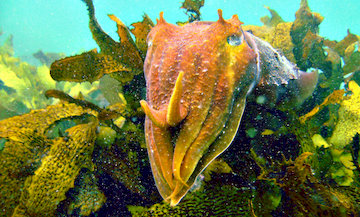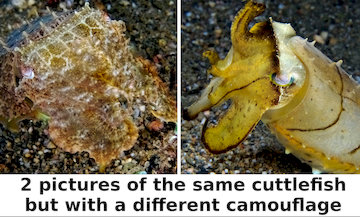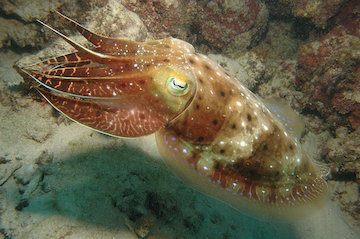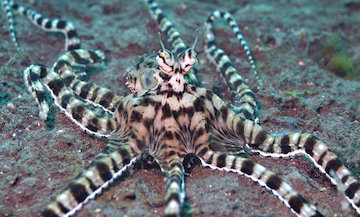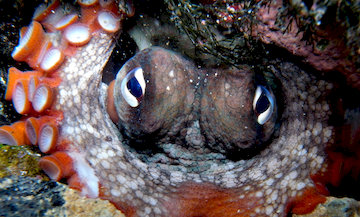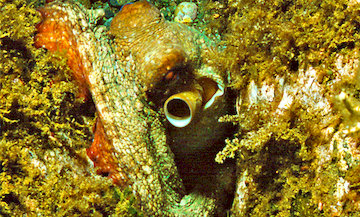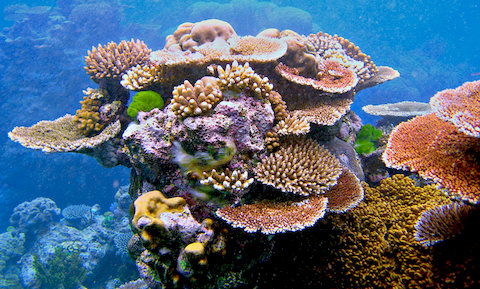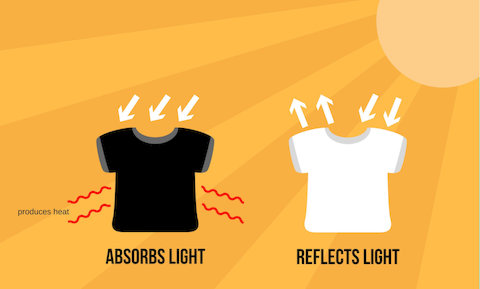How do octopuses camouflage and why they do it?
Have you ever seen an octopus, squid, or cuttlefish appear out of nowhere?
Or, have you seen one disappear before your very eyes, like you just watched a magic trick?
If so, have you considered why they hide like that? More likely, have you thought about how they can mimic their environments so well? Or, have you wondered how fast an octopus can change colors? Below, we will answer these questions and even more.
How fast can a Cephalopod change colors?
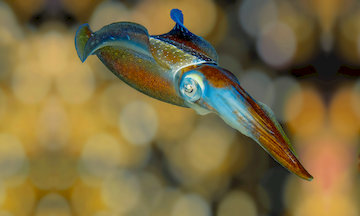 But First: What does Cephalopod mean?
But First: What does Cephalopod mean?
Cephalopods means arms attached to their heads, they are a group of molluscs consisting of squids, octopuses, and cuttlefishes.
They are the ultimate masters of disguise. While there are animals that can blend into their environments, cephalopods are special because they can blend into multiple environments, including completely new and strange environments.
A cephalopod like an octopus, can change its color, skin tone, and texture to blend into its environment, resemble an inanimate object, or even mimic a completely different species. Although some advanced transformations may take several minutes, many of these transformations can occur in less than a second, like a reflex action.
Octopus and Cuttlefish are the Ultimate Chameleons
Chameleons cannot be compared to octopuses or other cephalopods. First of all, chameleons are only capable of creating color patterns. Second, they change colors relatively slowly, especially compared to the cuttlefish or the squid.
It might take a chameleon several minutes to do something an octopus, cuttlefish, or a squid can do within seconds. Furthermore, chameleons do not have control over their textures or body shapes the way cephalopods do.
Every cuttlefish, and octopuses are capable of changing its appearance to no longer look like its species at all.
The expression "like a chameleon" about hidding, should be "like an octopus or a cuttlefish".
Why do octopuses and other cephalopods camouflage themselves?
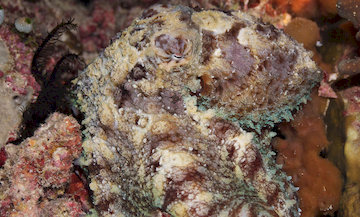 The primary reason that an organism would have to camouflage itself would be to hide from predators. While most organisms with changing color capability are satisfied enough to blend into their surroundings, a cephalopod does not stop there.
The primary reason that an organism would have to camouflage itself would be to hide from predators. While most organisms with changing color capability are satisfied enough to blend into their surroundings, a cephalopod does not stop there.
Another reason is to hide from prey. It is much easier to catch prey if it unsuspectingly comes to you. Potential prey wanders into areas without any awareness that a camouflaged predator is there. Before the prey can react or escape, arms appear out of nowhere and snare it.
Squids, cuttlefishes, and octopuses also prefer privacy. They don't like to swim or rest out in the open water. Instead, they prefer to find holes to hide in. If they cannot find good places to hide, they then camouflage themselves and hide in plain sights.
How do cuttlefishes and other cephalopods change their color?
Cephalopods change colors and create patterns with subcutaneous chromatophores. Think of chromatophores as dye-filled balloons. When muscles squeeze these "balloons," the dye inside seems brighter. When they stretch their muscles the chromatophore extends to cover more surfaces with its color.
Some cephalopods have iridophores and leucophores. What's The difference between leucophores and iridophore? Iridophores add to the color a metallic, reflective, or iridescent effect. Leucophores allow a cephalopod to turn white or reflect colors from its surroundings.
To determine which colors to change into, and at what brightness, cephalopod skin contains the same light-sensitive proteins as its eyes. These proteins interact directly with the chromatophores, shortening transformation times. They vary their responses to different light colors and to different levels of brightness.
How do octopuses and other cephalopods change their texture?
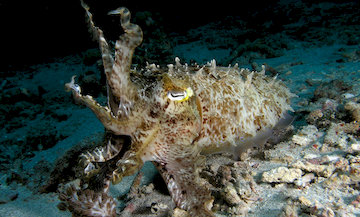 Cuttlefishes, octopuses, and squids can also change their skin texture by altering the size of papillae on their skin. To understand papillae, imagine humans having complete control over our goosebumps.
Cuttlefishes, octopuses, and squids can also change their skin texture by altering the size of papillae on their skin. To understand papillae, imagine humans having complete control over our goosebumps.
For cephalopods, these textural changes eliminate the types of edges that predators use to spot their prey. It is unknown, however, how some cephalopods determine texture despite having their eyes on each side of their heads.
Also, cephalopods can visually enhance their texture. The chromatophores in their skin are in layers, so expanding chromatophores in some areas but exposing the white bottom layer in other areas, each octopus, squid, and cuttlefish can add contrast to its patterns and textures.
How else can octopuses and other cephalopods camouflage themselves?
Some cephalopod species can create bioluminescence . Like bending a glowstick to activate it, these cephalopods internally combine two chemicals that react to form a third, luminescent chemical. Squids that have photophores and chromatophores can control the color and intensity of the light.
The Mimic Octopus takes camouflage one step further than other cephalopod species. It changes its color and shape to resemble a different species! To other marine animals, a Mimic Octopus may look like a flatfish, flounder, lionfish, sea snake, or one of at least 11 other species!
Transformation speed is due to using only on a limited number of patterns. With a visual cue, the cephalopod determines which pattern to implement. These patterns are not perfect camouflage; the level of detail merely needs to fool their predators' vision. Camouflaging themselves in an unusual surrounding can take several minutes.
Is camouflage a cuttlefish's or cephalopod's only defense?
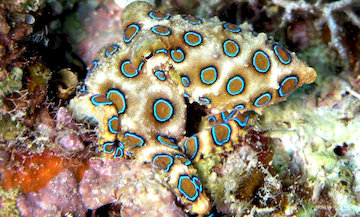 Some cephalopods use their camouflage abilities for more than just blending into their surroundings. Some species will change their colors as a warning to potential predators to try to scare them off. Or, a quick transformation may be enough to startle a predator long enough to escape.
Some cephalopods use their camouflage abilities for more than just blending into their surroundings. Some species will change their colors as a warning to potential predators to try to scare them off. Or, a quick transformation may be enough to startle a predator long enough to escape.
Alternately, a squid, octopus, or cuttlefish may turn itself white to create the illusion that it is bigger than it actually is.
At least one octopus species is venomous. In fact, the venom of blue-lined octopuses (blue-ringed octopuses) can cause respiratory failure in other animals, including humans. As previously stated, these octopuses uses their camouflage abilities to create a pattern of blue rings as a warning to potential predators.
How do octopus escape when seen?
Cephalopods are masters of escape, especially octopuses. The only rigid part of an octopus body is its beak. On the other hand, cuttlefishes have what's called the cuttlebone and squids have the pen. Therefore, octopus can squeeze its entire body through any opening that it can fit its beak through. Predators without that same capability are simply not able to continue their pursuit.
Another means of escape is releasing ink. An octopus, cuttlefish, or squid can squirt black ink directly at a predator, and then use the darkness to hide its movement.
Similarly, magic shows, ninjas, and so forth, release smoke to hide movement. Some squid species further confuse predators by releasing bioluminescent ink!
How else can a cuttlefish or other cephalopod use its camouflage ability?
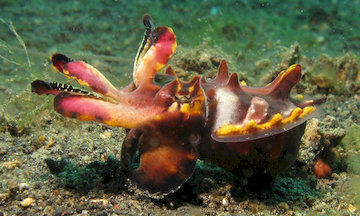 Cephalopods use their camouflage abilities to communicate. Because they are known to be colorblind, it is believed that cuttlefishes, squids, and octopuses send signals by creating and changing patterns. Very little is known, however, about how they communicate by using patterns.
Cephalopods use their camouflage abilities to communicate. Because they are known to be colorblind, it is believed that cuttlefishes, squids, and octopuses send signals by creating and changing patterns. Very little is known, however, about how they communicate by using patterns.
Cephalopods also alter their appearances to find mates. Males use colors and textures to attract females.
At least one species is known to attract females on one side of its body while at the same time scaring off other males with the other side of its body. Squids that can produce light of variable intensities use this ability to do these things.
What are the benefits to learning how octopuses and other cephalopods camouflage themselves?
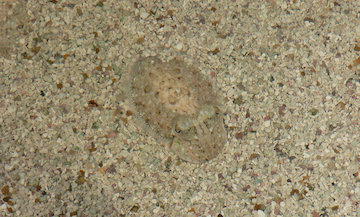 The first practical application that will come out of understanding cephalopod camouflage will be military camouflage. Suits for personnel and covers for vehicles could be used to better alter their colors and shapes to blend in with their surroundings.
The first practical application that will come out of understanding cephalopod camouflage will be military camouflage. Suits for personnel and covers for vehicles could be used to better alter their colors and shapes to blend in with their surroundings.
The shipping industry could benefit from the shape changing ability in many ways. Fragile items could be protected through the use of rigid, re-useable, and form-fitting shipping materials.
The virtual reality industry could be revolutionized. Imagine wearing a virtual reality headset, reaching out with your hands, and feeling whatever it is you are looking at! As you move around or look around, your surroundings could continuously adjust.
How would understanding octopus or cephalopod camouflage advance medical science?
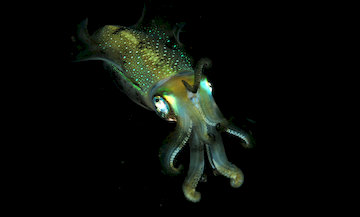 Medical science could benefit through from the development of soft robotics and prosthetics. Adding texture-changing capabilities to synthetic skin could grant dexterity that is difficult-to-impossible with hard surfaces.
Medical science could benefit through from the development of soft robotics and prosthetics. Adding texture-changing capabilities to synthetic skin could grant dexterity that is difficult-to-impossible with hard surfaces.
The medical field could also benefit from the creation of artificial muscles. Rubber that is pressurized with air could contract and stretch, thus allowing flexing and extending.
Finally, we may learn more about how eyes evolved. Looking at cephalopods, it is possible that the light-detecting cells in their skin evolved first. As these organisms evolved, some of these cells may have specialized and evolved into "eyes". Understanding cephalopod evolution may help us understand our own.
Last, but not Least
If you are interested in watching a documentary about these intriguing creatures, we suggest you watch this excellent video on YouTube. It is called Cuttlefish Kings of Camouflage.
It's a 50-minute documentary about cuttlefishes, and it shows off the absolutely incredible things they can do with their color-changing and texture-changing capabilities.
We also want to thank YouTube for the other amazing videos on this page, plus Wikimedia Commons for the incredible images that we are using on this page.
And as always
If you would like to receive interesting content like this in your email Inbox, subscribe to our newsletter.
In addition to our monthly newsletter, we will send you our weekly e-Circular with one fascinating topic, like cephalopod camouflage. There will be no advertising or sales pitch.
Thanks for reading and see you next week, if you wish!
The Research and Media Team at Scotty's.
Few Pictures of cephalopod camouflages

